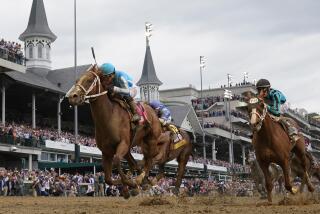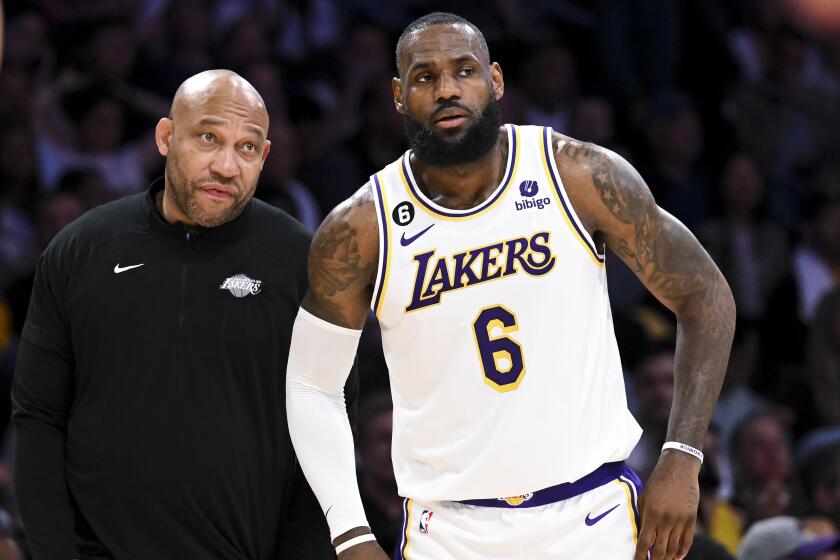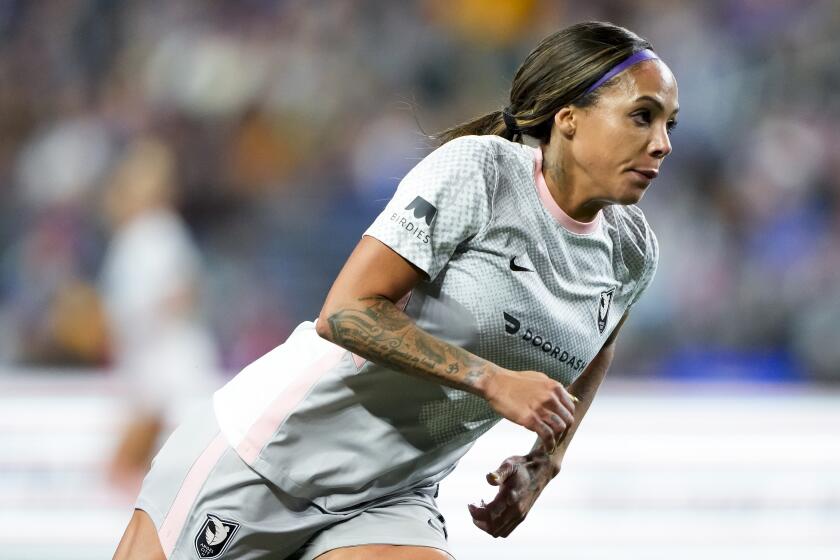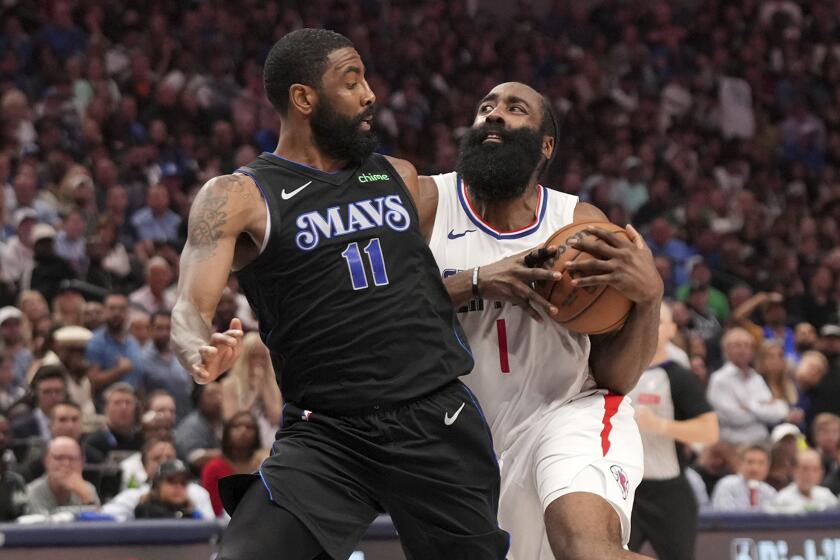NFL PREVIEW 1988 : NFC to Remain Dominant : It Looks Like the 49ers’ Turn to Continue Conference’s Hold on Super Bowl
It’s this way in the National Football League: There has been a new champion every year in the 1980s, and most of the winners have come from the National Football Conference.
And if, as some expect, the San Francisco 49ers win the Super Bowl this time, the American Football Conference will be well on its way to a record that it doesn’t really want.
AFC teams will have lost five consecutive Super Bowls and seven of the last eight, reversing the trend of the 1970s, when they won five in a row and eight of nine.
That reversal, however, doesn’t throw much light on the larger question: Why does a different group of apparently omnipotent championship players arise every January?
The Raiders, looking close to invincible, dominated postseason play in 1984. The streaking 49ers did the same in 1985, followed by the oppressive Chicago Bears in 1986, the awesome New York Giants in 1987 and the Washington Redskins, who turned Super Bowl XXII into a rout last January.
When football teams dominate so convincingly one year, why can’t they at least scratch out another championship the next year?
The answer seems to be that despite the long stretch of lopsided Super Bowl scoring, the talent on the NFL’s contending teams each season is almost equally divided.
“In this era, it’s impossible to build a dynasty in pro football.” Dick Steinberg, the New England Patriots’ director of player development, said the other day. “You know who the great players are, but you can’t get enough of them on your team before someone else (drafts) them.”
What has happened, specifically, is that in recent years, many--if not most--NFL coaches and front-office staffs have learned more of what there is to know about recruiting winning players and conditioning them to win.
“The most you can ever have at the same time now are three or four great players on each side of the ball,” Steinberg said. “But that’s all anyone else has. So if you’ve got ‘em, you’ve got a chance.”
In 1980s pro football, two such teams usually make it to the Super Bowl. And, there, the winner tends to be the one with the better defense, which, by destroying the other team’s morale, gets in position to win big. The average score of the last four Super Bowls: 41-14.
The Redskins, Giants, Bears, 49ers and Raiders have all had a balance of super players in small cadres--on both sides of the ball--in this decade. Thus, it should come as no surprise that these five teams have taken turns winning the last eight Super Bowls, although lately, the Raiders have lost their edge.
The Minnesota Vikings developed the required great-athlete balance last season and probably lead the NFC now in number of quality players. Their top 30 seem clearly more talented than the Redskins’ top 30.
The Redskins, however, with Coach Joe Gibbs and his personnel chief, Bobby Beathard, have the edge in leadership.
In San Francisco, where Bill Walsh is both coach and personnel chief, the 49er leadership is about a match for the Redskins’. And Walsh’s players are nearly as skilled as Minnesota’s. It should be another 49er year.
The National Conference in 1988:
NFC WEST
San Francisco 49ers: Because pro games tend to be won and lost when the ball is in the air, Bill Walsh makes sure that his passing personnel is second to none--offensively or defensively. The 49ers employ the league’s best receiver, Jerry Rice, along with two quarterbacks who can get him the ball, Joe Montana and Steve Young. On defense, Walsh lines up two of the NFL’s top 8 or 10 cornerbacks, Don Griffin and Tim McKyer, and two of the top 8 or 10 safeties, Ronnie Lott and Jeff Fuller. The Roger Craig-Tom Rathman backfield, with improving Terrence Flagler also available, is one of the NFC’s finest. Most Western teams, the 49ers among them, could use a better pass rush.
New Orleans Saints: This club lacks San Francisco’s commitment to pass offense and pass defense. The passer, Bobby Hebert, is a technician who doesn’t scare anyone. What’s worse, New Orleans receivers lack speed, and, on the other side of the ball, so does the secondary. What the NFL has in Louisiana is a team that’s a throwback to Vince Lombardi’s carefully coached, machine-like 1960s teams in Green Bay. Coach Jim Mora’s goal is to cut every Saint’s mistakes to zero. His only real talent is a rookie running back, Craig (Ironhead) Heyward.
Rams: The question is how long it will take a running team to become a passing team. The No. 1 Ram asset is the motivator, John Robinson.
Atlanta Falcons: No hope.
NFC CENTRAL
Minnesota Vikings: Signal-calling inside their opponents’ 10-yard line beat the Vikings last year in critical games against the Bears, Redskins and others, keeping them out of the Super Bowl. They didn’t appear to have a short-yardage offense after their big-play offense got them close. Their coaches also seem to lack appreciation for the man who threw most of the big passes, Wade Wilson, and the man who caught them, Anthony Carter. They rarely used Carter last year, and they’re talking about Tommy Kramer at quarterback this year. Their personnel, however, is probably the NFC’s most gifted. Few NFL teams have a defensive pair to match linemen Chris Doleman and Keith Millard.
Chicago Bears: Every NFC coach says the same thing: If quarterback Jim McMahon plays all 16 games, the Bears are in the playoffs. But he started only six last year, and, in the last six years, few NFL quarterbacks have taken more hits. The cast around him is also weaker now. The Bears have let go of their best receiver, Willie Gault, who is now a Raider, and their best outside linebacker, Wilber Marshall, who went to Washington. The injury to linebacker Otis Wilson seemed the last straw after five offensive linemen underwent surgery.
Green Bay Packers: A Raider clone with a new coach, Lindy Infante, and no quarterback.
Tampa Bay Buccaneers: Some hope with quarterback Vinny Testaverde.
Detroit Lions: A sore-armed passer, Chuck Long, and not much else.
NFC EAST
Washington Redskins: Doug Williams is probably the best quarterback the Redskins have had since Sonny Jurgensen a generation ago, but at 33 Williams can look back on as much punishment as McMahon has taken. Although this team has turned up some other aces--receivers Gary Clark, Art Monk and Ricky Sanders, cornerback Darrell Green, defensive linemen Charles Mann and Dexter Manley, and perhaps runner Timmy Smith--its real strength is Gibbs and Beathard.
New York Giants: Ably led by Coach Bill Parcells and General Manager George Young, the Giants will be a factor in the weak second half of their schedule if they can win in the first half with quarterback Phil Simms and without problem child Lawrence Taylor. Their running attack isn’t as sound as Washington’s, and neither is their offensive line.
Philadelphia Eagles: Coach Buddy Ryan will get the Eagles into the playoffs within a year or so if he has the unqualified support of club ownership. He has made the right moves, promoting Randall Cunningham at quarterback, adding Jerome Brown and others to the defense, and getting the most out of receiver Mike Quick and other veterans. And in end Reggie White, he has the best defensive player in the game.
Dallas Cowboys: Coach Tom Landry traded Tony Dorsett in order to build the team around Herschel Walker, a fast, strong big back who doubles as one of the league’s great receivers. What else do you need in a running back?
Phoenix Cardinals: Quarterback Neil Lomax heads an improving cast of players, but they’re in the most competitive division of the NFC.
1987 NFL STANDINGS National Conference
West W L T Pct. PF PA San Francisco (3-0) 13 2 0 .867 449 263 New Orleans (2-1) 12 3 0 .800 422 283 Rams (1-2) 6 9 0 .400 317 361 Atlanta (1-2) 3 12 0 .200 205 436 East W L T Pct. PF PA Washington (3-0) 11 4 0 .733 379 285 St. Louis (1-2) 7 8 0 .467 362 368 Dallas (2-1) 7 8 0 .467 340 348 Philadelphia (0-3) 7 8 0 .467 337 380 NY Giants (0-3) 6 9 0 .400 280 312 Central W L T Pct. PF PA Chicago (2-1) 11 4 0 .733 356 282 Minnesota (0-3) 8 7 0 .533 336 335 Green Bay (2-1) 5 9 1 .367 255 300 Tampa Bay (2-1) 4 11 0 .267 286 360 Detroit (1-2) 4 11 0 .267 269 384 American Conference West W L T Pct. PF PA Denver (2-1) 10 4 1 .700 379 288 Seattle (2-1) 9 6 0 .600 371 314 San Diego (3-0) 8 7 0 .533 253 317 Raiders (1-2) 5 10 0 .333 301 289 Kansas City (0-3) 4 11 0 .267 273 388 East W L T Pct. PF PA Indianapolis (2-1) 9 6 0 .600 300 238 Miami (1-2) 8 7 0 .533 362 335 New England (2-1) 8 7 0 .533 320 293 Buffalo (1-2) 7 8 0 .467 270 305 NY Jets (1-2) 6 9 0 .400 334 360 Central W L T Pct. PF PA Cleveland (2-1) 10 5 0 .667 390 239 Houston (2-1) 9 6 0 .600 345 349 Pittsburgh (2-1) 8 7 0 .533 285 299 Cincinnati (1-2) 4 11 0 .267 285 360
Note--Strike records in parentheses
More to Read
Get our high school sports newsletter
Prep Rally is devoted to the SoCal high school sports experience, bringing you scores, stories and a behind-the-scenes look at what makes prep sports so popular.
You may occasionally receive promotional content from the Los Angeles Times.






